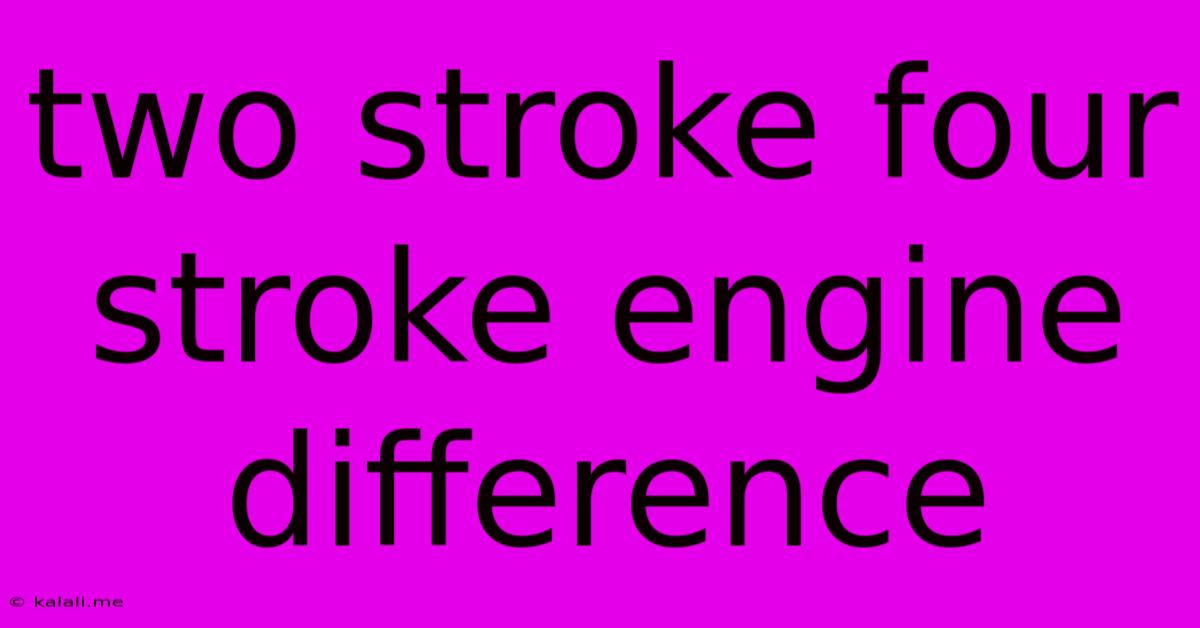Two Stroke Four Stroke Engine Difference
Kalali
May 19, 2025 · 3 min read

Table of Contents
Two-Stroke vs. Four-Stroke Engines: A Comprehensive Comparison
Choosing the right engine for your needs depends heavily on understanding the core differences between two-stroke and four-stroke engines. This article delves into the mechanics, performance characteristics, and applications of each, helping you make an informed decision. Whether you're a seasoned mechanic or a curious beginner, this guide provides a clear and concise overview of two-stroke versus four-stroke engine technology.
Understanding the Basics: The Stroke Cycle
The fundamental difference lies in the number of piston strokes required to complete one combustion cycle. A stroke refers to the piston's movement from top dead center (TDC) to bottom dead center (BDC) and vice versa. This simple concept significantly impacts engine design, performance, and emissions.
Two-Stroke Engines: Power and Simplicity
Two-stroke engines complete a power cycle in just two piston strokes. This translates to a simpler design with fewer moving parts, resulting in a lighter and more compact engine. The simplicity makes them cost-effective to manufacture. However, this efficiency comes at a cost.
How it works: In a two-stroke engine, intake and exhaust happen simultaneously, requiring a more complex porting system in the cylinder wall. This system controls the flow of fuel-air mixture and exhaust gases. Lubrication is often achieved by mixing oil directly into the fuel.
Advantages:
- Lightweight and compact: Ideal for applications where size and weight are critical, such as motorcycles, chainsaws, and outboard motors.
- High power-to-weight ratio: Delivers significant power for its size.
- Simple design and lower manufacturing cost: Fewer parts translate to lower production costs.
Disadvantages:
- Higher emissions: The simultaneous intake and exhaust leads to significant unburned fuel escaping, resulting in higher emissions.
- Less fuel-efficient: More fuel is consumed per unit of power produced compared to four-stroke engines.
- Requires oil mixed with fuel: This necessitates using specialized fuel mixtures and can lead to engine fouling if the mixture is incorrect.
- Higher vibration and noise: The simpler design and faster combustion cycle result in more vibration and noise.
Four-Stroke Engines: Efficiency and Refinement
Four-stroke engines, on the other hand, complete one power cycle in four piston strokes. This allows for distinct stages of intake, compression, combustion, and exhaust.
How it works: Each stroke has a dedicated function. The intake stroke draws the fuel-air mixture into the cylinder. The compression stroke compresses the mixture. Combustion occurs when the spark plug ignites the compressed mixture. Finally, the exhaust stroke pushes the spent gases out of the cylinder. Lubrication is usually achieved through a separate oil sump.
Advantages:
- Higher fuel efficiency: Better combustion and separation of processes lead to improved fuel economy.
- Lower emissions: More complete combustion results in lower levels of harmful emissions.
- Longer lifespan: The more robust design and better lubrication contribute to longer engine life.
- Smoother operation: Less vibration and quieter operation compared to two-stroke engines.
Disadvantages:
- Heavier and larger: More complex design translates to increased weight and size.
- Higher manufacturing cost: More parts and complex manufacturing processes increase production costs.
- Lower power-to-weight ratio: Less power output per unit of weight compared to two-stroke engines.
Choosing the Right Engine: Applications and Considerations
The choice between a two-stroke and a four-stroke engine often depends on the specific application.
-
Two-stroke engines are preferred for applications requiring high power-to-weight ratio, portability, and simplicity, such as:
- Small engines for recreational equipment: Chainsaws, weed whackers, and outboard motors.
- Motorcycles (certain types): Smaller, lightweight motorcycles often utilize two-stroke engines.
-
Four-stroke engines are better suited for applications prioritizing fuel efficiency, lower emissions, and longevity, such as:
- Cars and trucks: The vast majority of automobiles utilize four-stroke engines.
- Large motorcycles and scooters: These often benefit from the increased power and torque of four-stroke engines.
- Industrial equipment: Applications demanding reliable, long-lasting power.
Ultimately, the best choice depends on prioritizing factors like power, efficiency, emissions, cost, and maintenance. By understanding the fundamental differences between two-stroke and four-stroke engines, you can make a more informed decision for your specific needs.
Latest Posts
Latest Posts
-
How To Say How In French
May 19, 2025
-
Why Did Elliot Stabler Leave Svu
May 19, 2025
-
Do Passport Numbers Change When Renewing
May 19, 2025
-
How Do You Say With In German
May 19, 2025
-
Is It Haram To Watch Porn
May 19, 2025
Related Post
Thank you for visiting our website which covers about Two Stroke Four Stroke Engine Difference . We hope the information provided has been useful to you. Feel free to contact us if you have any questions or need further assistance. See you next time and don't miss to bookmark.